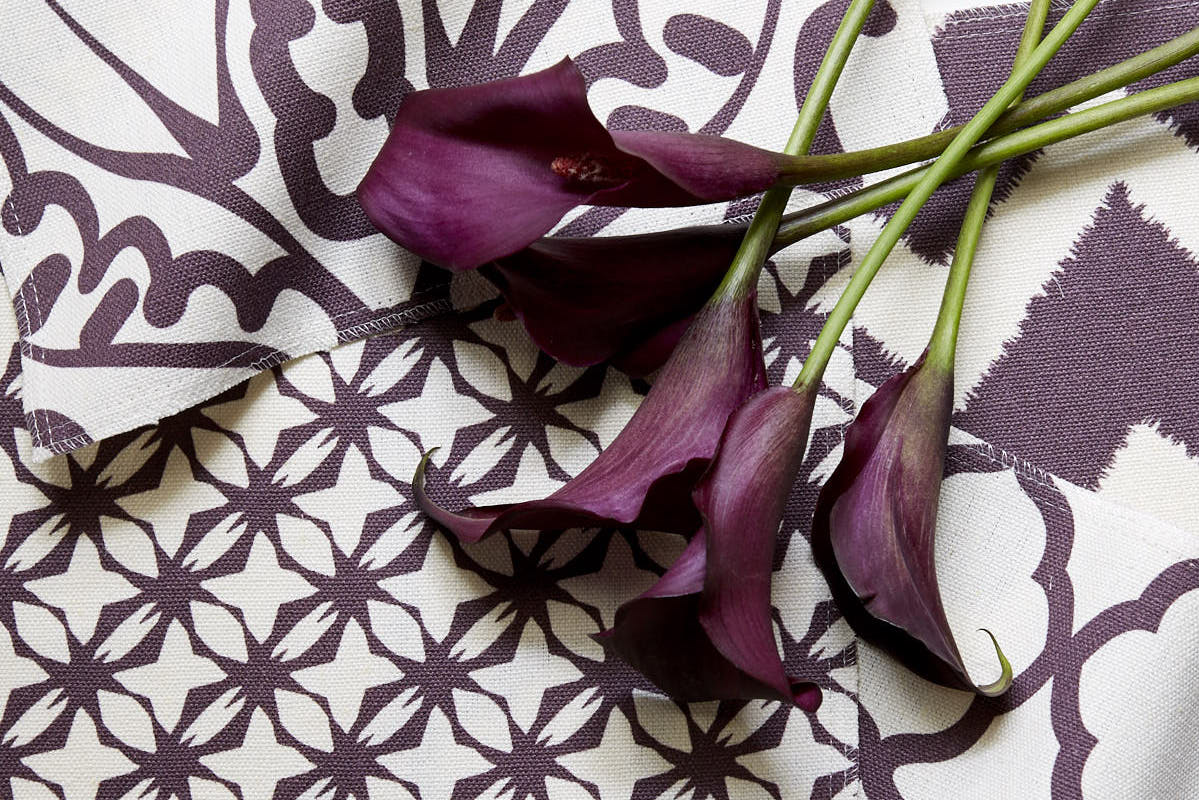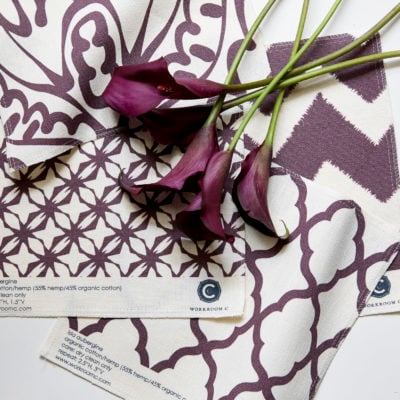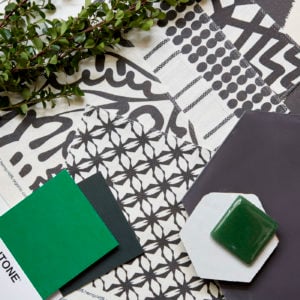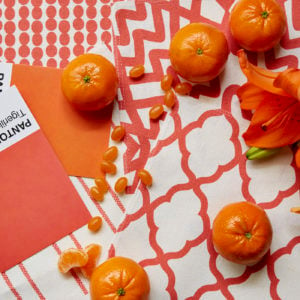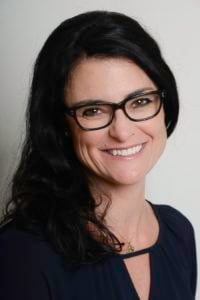The Art of the Pattern — Q & A with Carolyn Rebuffel Flannery of Workroom C
Carolyn Rebuffel Flannery, Principal Designer of Interior Design Firm Workroom C, based in Emeryville, offers her brand of “inspired, practical design” to clients throughout the Bay Area. With that mission comes the textiles she custom-creates to help implement her visions, making homes simply more beautiful — and colorful! We sat down with the busy designer in her light-filled studio to learn more about her creative process.
One aspect of what you do is to custom-designed patterned fabrics for your clients. Where do you get your inspiration? Going to museums! That’s one place, but I see pattern everywhere! Sometimes I will make notes about a pattern that I see, in art, in nature, that I feel like I want to do something with. Also: when there’s a pattern in my head and I can’t find it! For example, I designed my own “mattress ticking,” because I think that ticking should be in any color. You can easily find it in red, blue, or black, but not yellow, bright green, or orange!
How do you decide on the names for your patterns? My husband and I have four kids (ages 23, 21, 20, and 19). They inspire me in many ways. All of the patterns I’ve created are named after girls that are in my family, and the families of all of the creative people I’m working with. We have three daughters; they all have patterns. We didn’t name one after my son; Connor doesn’t mind!
How does your process for creating a pattern work? I start with a sketch and then, because pattern making has an interesting component of being creative, but also, you’re making choices and extrapolating. Whether you do a half-drop (a pattern that repeats in an uneven way such that if you cut it in half, the two sides would be offset) or a mirror-image, or just a very simple curve. For example, if we take a Moroccan-tile kind of pattern, getting that curve to do exactly what I want it to do, drawing it so that the line is not too thick or thin, so that the element is not too big or small: first I’m sketching it, then I’m playing with how it extrapolates out, then refining, and refining. Next, I turn it into a vector file for digital printing. Then comes testing the colors. I know, this is the color I want, but how is it going to translate on to this particular fabric? Digital image versus woven material printing is very different. Ink sits on top of a fabric. But I want the result to feel as organic as possible — as organic as a digital process can be — so I’m looking at how to meld a vision that is creative and flowy and organic with technology that is a little more rigid.
So you are trying to replicate the look and feel of hand-woven patterned textiles? Yes! That doodle that turns into a pattern — we play with the texture of the doodle so that it ends up printing in a way that looks more woven. We may try to make the pattern look as if it was drawn by hand. It’s almost like distressing blue jeans — distressed digital drawings. So we make lines that are not exact. We deliberately do not use the tools available in digital that would make it perfectly straight or even. We want variation.
Your aesthetic is beautiful, and you emphasize ease and livability. It makes sense that you might aim for the exact right amount of imperfection. Can you say more about this? Raising four kids, you learn quickly that nothing is perfect. Everything is messy. If something is already a little bit messy, I think it wears better. Not that we are deliberately adding stains to fabric! If you can sense a quality of handmade, I think that creates more ease. To have everything perfect and exactly aligned, that feels uncomfortable to me. For example, handmade tiles from Fireclay are much more attractive to me than those from a company whose tile is machine-made and has that rigid exactitude. Fireclay tile has more of a hand in it. One of the reasons I did this in the first place was that I hate wasting fabric. When you have a fabric that has a giant repeat (the primary pattern or shape that is repeated) it ends up that you can only make one 20-inch pillow with one yard. Giant repeats are great for drapes and duvets. But when you’re making pillows with it, you have to waste a lot of yardage to have the pillows be identical. If I can ‘contain’ the repeat, I waste less fabric. You will notice that my patterns are much more regular. I won’t do a floral with a repeat that goes on for 30 inches in every direction. Also, custom coloring with traditional textile producers is really expensive and has large yardage minimums. When I create a pattern, I can print just one yard. I can do it in any color. I have a giant book of colors. So we can do a test swatch when we are making design decisions, and I’ve kept the project cost down.
What are the requirements for getting test swatches from a big distributor? They usually have a three-to-five-yard minimum, with a long lead time for custom color, and then there is usually a per-yard surcharge. We can do this inexpensively and a lot faster, with more ability to customize. If the client and I fall in love with one of those large repeat textiles, I will sometimes talk them into pillows that are not perfectly centered. Or we do pillows that have all matching fronts with that single repeat, but the backs are done in a different pattern. The backs are all the same, but fronts and backs won’t match.
Because if it will cost you so much money to match and align everything perfectly, then let’s mix it up and mess it up a little bit! Obviously, if there’s a giant peacock in the middle of the fabric, you really can’t cut off his head, so you have to work around what you have chosen. When I look at a big expansive fabric pattern, I want it to be draperies. I want to see the repeat. That is my own aesthetic need — which is probably weird!
We don’t think you are weird! We love your aesthetic. Surely your clients choose you for it. How do you introduce the idea of a pattern to them, custom or otherwise? I usually bring in a few different ideas during the initial client meetings. During that phase, I am looking at what they are gravitating towards. I give the person a stack of fabrics and I say: “Throw out what you hate, and hand me what you love.” That’s a jumping off point for me. One client said she didn’t want any pattern on anything because she felt patterns were too dissonant for her. Texture was fine, tone-on-tone was fine, but anything further, she didn’t want it. So, she did not choose any patterns that were not tone-on-tone, but we did use some great, punchy wall color in the bedroom, dining room, and living room. And a fantastic black crystal chandelier over the dining table. The final design relied on color and eye-catching art for the drama rather than any pattern play.
How would you describe your personal aesthetic? What patterns do you prefer? I’m more drawn to regular repeats. When a pattern meanders, I long for something that’s regular; I find a regular pattern comforting. I like how I can see something new in it. I think that it’s much more powerful to use a piece of art as a large visual element that has different things you are invited to look at — in my room designs, I would rather see be drawn in in that way by the art in the home, rather than by images in the fabrics. One of my daughters says I’m very matchy-matchy and I should loosen up a little bit! It’s true. I’m very inclined towards symmetrical, and I want everything to match. As long as it’s not perfect — so that’s where I’m more relaxed, in a way. Because I want to see and feel the variation that exists in the hand, and in nature.

